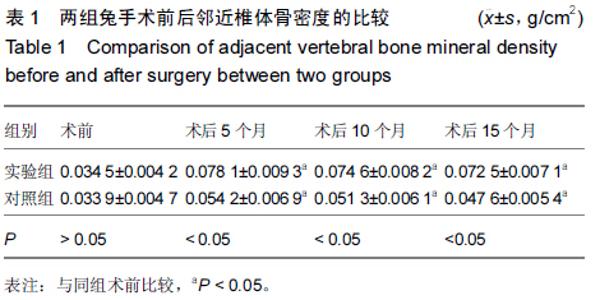| [1] 金桥,沈文.经皮椎体成形、经皮椎体后凸成形灌注骨水泥相关临床应用的再评价[J].中国组织工程研究,2015,19(3):465-471.
[2] 黄晓楠.骨质疏松性椎体压缩骨折治疗: 注入高黏度与低黏度骨水泥的对比[J].中国组织工程研究,2014,18(16):2461-2467.
[3] 陈学忠,董玮,奚江明,等.高黏度与低黏度骨水泥在椎体成形术中应用的临床对比研究[J].成都医学院学报,2015,10(2):186-189.
[4] 笪晓伟,李启中,区杰雄,等.高黏度与低黏度骨水泥在经皮椎体后凸成形术中的应用比较[J].中国骨科临床与基础研究杂志, 2015, 7(2):79-83.
[5] 周英杰,赵鹏飞,郑怀亮,等.两种骨水泥应用于老年胸腰椎骨折椎体成形术的疗效观察[J].中国矫形外科杂志,2015,23(4): 364-367.
[6] 傅俊伟,陈卓,余冬梅,等.高黏度骨水泥治疗骨质疏松性椎体压缩骨折 34 例分析[J].中国骨与关节损伤杂志,2015,30(3): 305-306.
[7] 李波,余雨,卢昊鹏,等.高粘度骨水泥注入椎体成形术治疗急性重度骨质疏松椎体压缩性骨折[J].激光杂志,2013,34(6):118-119.
[8] 张树芳,陈荣春,江建明,等.带负电荷硫酸钙/β-磷酸三钙复合骨水泥在椎体成形中的应用[J].中国组织工程研究,2014,18(12): 1805-1810.
[9] 秦毅,秦杰,江建明,等.BCC骨水泥椎体成形术强化骨质疏松性椎体压缩性骨折的实验研究[J].中国骨质疏松杂志,2013,19(8): 796-799.
[10] 傅远飞,孙兆瑶,陈德敏.含锶羟磷灰石无机骨水泥材料的制备和表征[J].稀有金属材料与工程,2014,43(1):38-41.
[11] 朱爱国,张烽,葛勇,等.硫酸钙骨水泥增强椎弓根螺钉置入骨质疏松椎体的瞬时稳定性[J]. 中国组织工程研究,2014,18(26): 4195-4199.
[12] Yimin Y,Zhiwei R,Wei M,et al.Current status of percutaneous vertebroplasty and percutaneous kyphoplasty–a review.Med Sci Monit.2013;19:826-836.
[13] Wang S,Wang Q,Kang JP.Percutaneous kyphoplasty by unilateral transverse process-pedicle approach for treatment of thoracolumbar osteoporotic vertebral compression fracture.Chin J Spine Spinal Cord.2012;7:622-627.
[14] 卞元健,黄永辉,谭玉辉.两种不同扩张方式椎体后凸成形术的生物力学比较[J].江苏大学学报:医学版,2014,24(5):423-426.
[15] 李志君,慈元,郑玉鹏,等.经皮椎体后凸成形注入骨水泥治疗骨质疏松性胸腰椎压缩骨[J].中国组织工程研究,2012,16(43): 8000-8004.
[16] Schroder HM,Petersen KK,Erlandsen M.Occurrence and incidence of the second hip fracture.Clin Orthop Relat Res. 1993;289:166-169.
[17] 钱卫庆,尹宏.口服与骨折局部应用淫羊藿对骨质疏松大鼠骨折愈合的影响[J].中国中西医结合杂志,2012,32(6):822-826.
[18] 程立明,丁铭,李子荣,等.羊骨质疏松模型在人类骨科研究中的作用[J].中国骨质疏松杂志,2008,14(6):441-447.
[19] Turner RT,Maran A,Lotinun S,et al.Animal models for osteoporosis.Rev Endocr Metab Dis. 2001;2(1):117.
[20] 张立元,张志国,郝建英,等.成年猪椎体骨质疏松生物力学模型的快速建立[J].实用骨科杂志,2013,19(8):713-716.
[21] 付鑫,谭杰,宋纯理,等.椎体内单次注射辛伐他汀对骨质疏松小型猪腰椎椎体骨质和椎弓根螺钉内固定稳定性的影响[J].中国脊柱脊髓杂志,2015,25(5):448-455.
[22] Jerome CP,Peterson PE.Nonhuman primate models in skeletal research. Bone.2001; 29(1):1-6.
[23] 包丽华,林华,李建华,等.二膦酸盐治疗对骨质疏松性骨痛、骨密度、骨强度的疗效及安全性评价[J].中华老年医学杂志, 2003, 22(11):659-662.
[24] 张远华,苏艳杰,黄潮桐.去卵巢联合糖皮质激素诱发兔骨质疏松模型的研究[J].中国临床解剖学杂志,2015,33(2):204-208.
[25] 杨丰建,林伟龙,朱炯.经皮椎体成形术和经皮椎体后凸成形术治疗骨质疏松性椎体压缩骨折[J].中国脊柱脊髓杂志,2011,21(1): 50-54.
[26] Tohmeh AG,Mathis JM,Fenton DC,et al.Biomechanical efficacy of unipedicular versus biepedicular vertebroplasty for the management of osteoporotic compression fracture. Spine (Phila Pa 1976).1999;24(17):1772-1776.
[27] 唐迎九,杨惠林,章洪喜,等.椎体后凸成形术与椎体成形术生物力学比较[J].临床骨科杂志,2010,13(1):77-79.
[28] 邹德威,马华松,邵水霖,等.球囊扩张椎体后凸成形术治疗老年骨质疏松脊柱压缩骨折[J].中华骨科杂志,2004,23(5):257-261.
[29] 夏平,冯晶.单双侧入路椎体后凸成形术治疗骨质疏松性椎体压缩骨折的生物力学研究[J].中国中医骨伤科杂志,2013,21(10): 11-13.
[30] 银乐乐,徐小雄,潘奇林,等.单侧与双侧经皮椎体后凸成形修复骨质疏松椎体压缩性骨折的Meta分析[J].中国组织工程研究,2014, 18(31):5030-5035.
[31] 周鹏,高雪梅,孟义兴,等.骨水泥经皮椎体成形术对骨质疏松椎体压缩骨折效果[J].齐鲁医学杂志,2015,30(2):200-201.
[32] 关海山,陈晨,冯皓宇,等.椎体成形术和椎体后凸成形术对邻近椎体椎间盘的生物力学影响[J].中国药物与临床,2008,8(9): 705-707.
[33] Fei Q,Li Q J,Li D,et al.Biomechanical effect on adjacent vertebra after percutaneous kyphoplasty with cement leakage into disc: a finite element analysis of thoracolumbar osteoporotic vertebral compression fracture. Zhonghua yi xue za zhi.2011; 91(1):51-55.
毛海青,杨惠林,陈亮,等.椎体后凸成形术对邻近节段的生物力学影响[J].江苏医药,2007, 33(3):220-223. |





